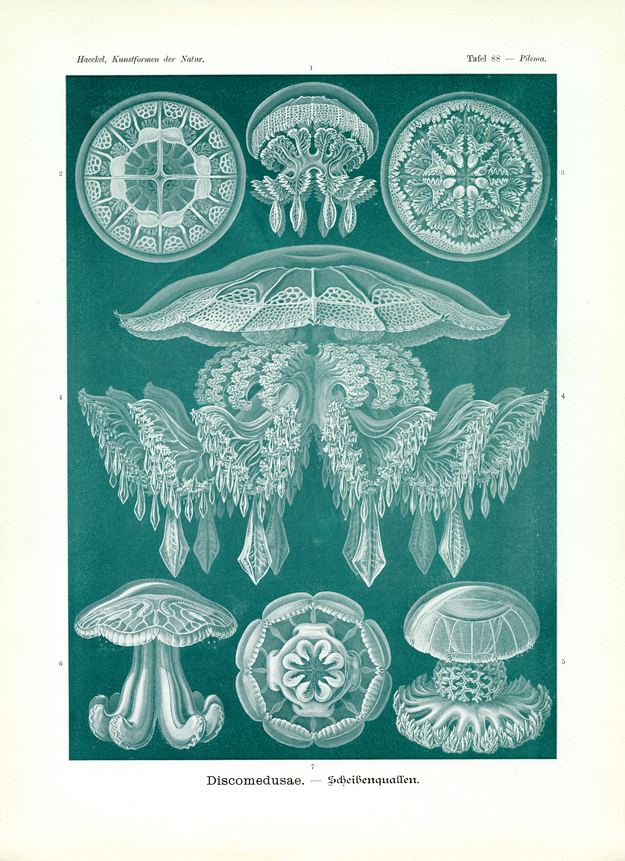Translation of the original German introduction by Ernst Haeckel:
Phylum of Cnidaria (Nesseltiere); - class of Acraspedae (Lappenquallen); - order of Discomedusae (Scheibenquallen); - suborder of Rhizostomae (Wurzelmündige).
‘Root-mouthed disc-medusae’ of this plate resemble in their basic body frame the Rhizostoma illustrated in plate 28. They are distinguished, however, by the varied formation of the eight ‘oral arms’ and the delicate appendages that develop along their ‘suction ruffles’. The cap-shaped gelatinous umbrella (Umbrella) that helps swimming shows a regular four-radial frame; in the centre of its concave base (Subumbrella) rests the disc-shaped stomach, surrounded by four inter-radial sexual glands (Gonades). 8 or 16 ‘radiant-canals’ branch off from the ambit of the stomach, proceeding from the base of the umbrella towards its circular rim producing, through extensive branching, a delicate canal-network. Eight ‘sensing-buds’ or Rhophalia sit in eight indentations of the loped umbrella rim, each composed of a ‘smell-groove’, an eye and a ‘hearing vesicle’ (vestibular organ). Capturing filaments or tentacles that sit along the umbrella edge of the other medusae have disappeared in Rhizostoma due to regression. All the more developed are the capturing organs located at the eight strong oral arms originating from bilateral division of the originally four (perridial) ‘mouth-lopes’. (Cf. the explanation of plate 28). Since in the early youth of all Rhizostoma the central part of the mouth opening overgrows and the frizzy wrinkles of the oral arms also coalesce in multiple ways, along its free plane thousands of small mouth openings form, leading food through delicate suction tubes into the stomach. The distinct “suction ruffles”, coming about in the process, are rarely simple (as in fig. 6, 7), rather heavily branched, folded and developed into cauliflower-like formations. In the family of Pilemida (fig. 1-5) the ‘suction-ruffle’ at each of the eight arms divides into two pieces, an upper ‘shoulder-ruffle’ (Skapuletta) and a lower ‘end-ruffle’ (Terminetta): the latter is studded with delicate, crystal-like gelatinous buttons and other appendages.
Translation by VR Translators Bangalore
We've scanned the original lithography at 1200dpi on the Epson A3 scanner of A3 scanner huren. You can download a 400dpi JPEG here.
